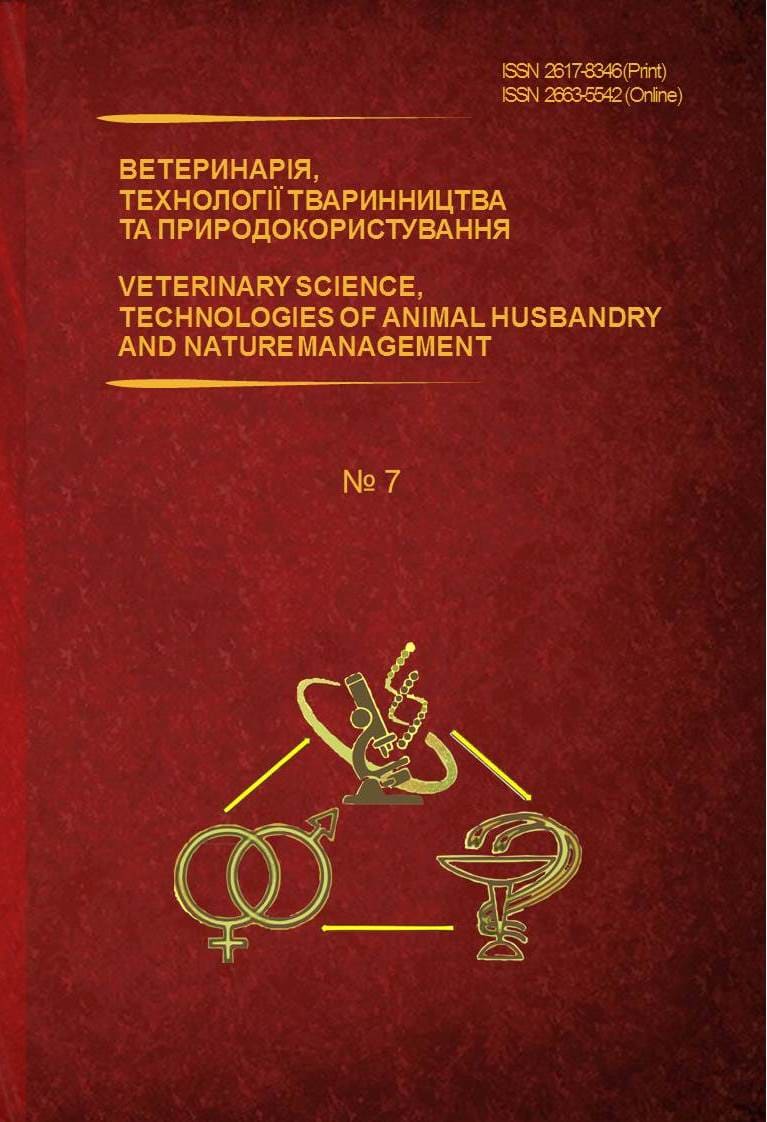Вміст ліпідів печінки щурів за дії композиції молочнокислих бактерій, виділених із традиційної карпатської бринзи
Анотація
Метою досліджень було вивчити вплив композиції молочнокислих бактерій E durans штаму SB18, L. lactis ssp. Lactis та Lb. plantarum, які виділені із традиційної карпатської бринзи, на ліпідний склад печінки щурів.
Встановлено, що на 14 добу експерименту у тканині печінки щурів, які отримували молочнокислі бактерії, вірогідно знижувався рівень неестерифікованого холестеролу та проявлялась чітка тенденція до підвищення рівня фосфоліпідів, естерифікованого холестеролу та зниження співвідношення холестерол/фосфоліпіди. На 21 добу експерименту виявлено суттєвіші відмінності у ліпідному складі печінки щурів між контрольною та дослідною групами.
Завантаження
Посилання
Ahmed, W., Sidhu, J. P., & Toze, S. (2012). Speciation and frequency of virulence genes of Enterococcus spp. isolated from rainwater tank samples in Southeast Queensland, Australia. Environmental science & technology, 46(12), 6843–6850. https://doi.org/10.1021/es300595g
Amaral, D., Silva, L. F., Casarotti, S. N., Nascimento, L., & Penna, A. (2017). Enterococcus faecium and Enterococcus durans isolated from cheese: Survival in the presence of medications under simulated gastrointestinal conditions and adhesion properties. Journal of dairy science, 100(2), 933–949. https://doi.org/10.3168/jds.2016-11513
Bao, Q., Song, Y., Xu, H., Yu, J., Zhang, W., Menghe, B., Zhang, H., & Sun, Z. (2016). Multilocus sequence typing of Lactobacillus casei isolates from naturally fermented foods in China and Mongolia. Journal of dairy science, 99(7), 5202–5213. https://doi.org/10.3168/jds.2016-10857
Chen, J., Wang, R., Li, X. F., & Wang, R. L. (2012). Bifidobacterium adolescentis supplementation ameliorates visceral fat accumulation and insulin sensitivity in an experimental model of the metabolic syndrome. The British journal of nutrition, 107(10), 1429–1434. https://doi.org/10.1017/S0007114511004491
Folch, J., Lees, М., & Sloane Stanley, G. H. (1957). A simple method for the isolation and purification of total lipides from animal tissues. Journal of Biological Chemistri, 226 (1), 497–509. https://doi.org/10.1016/S0021-9258(18)64849-5
Gesudu, Q., Zheng, Y., Xi, X., Hou, Q. C., Xu, H., Huang, W., Zhang, H., Menghe, B., & Liu, W. (2016). Investigating bacterial population structure and dynamics in traditional koumiss from Inner Mongolia using single molecule real-time sequencing. Journal of dairy science, 99(10), 7852–7863. https://doi.org/10.3168/jds.2016-11167
Gibbons, G. F., Bartlett, S. M., Sparks, C. E., & Sparks, J. D. (1992). Extracellular fatty acids are not utilized directly for the synthesis of very-low-density lipoprotein in primary cultures of rat hepatocytes. The Biochemical journal, 287 ( Pt 3)(Pt 3), 749–753. https://doi.org/10.1042/bj2870749
Goh, H. F., & Philip, K. (2015). Isolation and mode of action of bacteriocin BacC1 produced by nonpathogenic Enterococcus faecium C1. Journal of dairy science, 98(8), 5080–5090. https://doi.org/10.3168/jds.2014-9240
Guo, L., Li, T., Tang, Y., Yang, L., & Huo, G. (2016). Probiotic properties of Enterococcus strains isolated from traditional naturally fermented cream in China. Microbial biotechnology, 9(6), 737–745. https://doi.org/10.1111/1751-7915.12306
Ishimwe, N., Daliri, E. B., Lee, B. H., Fang, F., & Du, G. (2015). The perspective on cholesterol-lowering mechanisms of probiotics. Mol. Nutr. Food Res., 59, 94–105.
Kaur J. (2014). A comprehensive review on metabolic syndrome. Cardiology research and practice, 2014, 943162. https://doi.org/10.1155/2014/943162 (Retraction published Cardiol Res Pract. 2019 Jan 31;2019:4301528)
Kresiun, N. V., Son, H. O., Hodovan, V. V., & Hodlevskyi, L. S. (2017). Obmin lipidiv pry eksperymentalnomu tsukrovomu diabeti ta yoho korektsiia niatsyn-oksietylidendyfosfonatohermanatom. Zaporozhskyi medytsynskyi zhurnal, 19 (4), 497–503. Retrieved from http://nbuv.gov.ua/UJRN/Zmzh_2017_19_4_24. [In Ukrainian]
Kushnir I. (2020). Vplyv рН i riznykh kontsentratsiy soli ta zhovchi na rist enterokokiv, vydilenykh z pryrodnykh ekonish. Zbirnyk naukovykh prats «Tekhnolohiya vyrobnytstva i pererobky produktsiyi tvarynnytstva» = Animal Husbandry Products Production and Processing: zbirnyk naukovykh prats. Bilotserkivskyy natsionalnyy ahrarnyy universytet, 2(158), 76–81. https://doi.org/10.33245/2310-9289-2020-158-2-76-81. [In Ukrainian].
Kushnir, I., Tsisaryk, O., Kushnir, I., Semen, I., Slyvka, I., & Musiy, L. (2020). Properties of formed compositions of probiotic strains isolated from Carpathian bryndza. Scientific Messenger of LNU of Veterinary Medicine and Biotechnologies. Series: Agricultural Sciences, 22(93), 119-125. https://doi.org/10.32718/nvlvet-a9320 [In Ukrainian].
Li, Y., Wu, J., Cao, C., Zhu, X., Sun, X., & Wu, R. (2020). Effects of skim milk fermented with Lactobacillus plantarum WW on the constitutions of rats fed a high-fat diet. Journal of dairy science, 103(6), 5019–5029. https://doi.org/10.3168/jds.2019-17560
Molina, M. A., Diaz, A. M., Hesse, C., Ginter, W., Gentilini, M. V., Nunez, G. G., Canellada, A. M., Sparwasser, T., Berod, L., Castro, M. S., & Manghi, M. A. (2015). Immunostimulatory effects triggered by Enterococcus faecalis CECT7121 probiotic strain involve acti-vation of dendritic cells and interferon - gamma production. PLoS ONE, 10:e0127262. https://doi.org/10.1371/journal.pone.0127262
Nguyen, P., Leray, V., Diez, M., Serisier, S., Le Bloc'h, J., Siliart, B., & Dumon, H. (2008). Liver lipid metabolism. Journal of animal physiology and animal nutrition, 92(3), 272–283. https://doi.org/10.1111/j.1439-0396.2007.00752.x
Ooi, L. G., & Liong, M. T. (2010). Cholesterol-lowering effects of probiotics and prebiotics: a review of in vivo and in vitro findings. International journal of molecular sciences, 11(6), 2499–2522. https://doi.org/10.3390/ijms11062499
Ratu Safitri, Khusnul Khotimah, Roostita Balia, Muhammad Iqbal Saputra, Mia Miranti, & Gemilang Lara Utama (2016). The Tolerance of Lactobacillus paracasei and Lactobacillus curvatus Originated From Bovine Colustrum
Reuben, R. C., Roy, P. C., Sarkar, S. L., Rubayet Ul Alam, A., & Jahid, I. K. (2020). Characterization and evaluation of lactic acid bacteria from indigenous raw milk for potential probiotic properties. Journal of dairy science, 103(2), 1223–1237. https://doi.org/10.3168/jds.2019-17092
Slyvka, I. M., Tsisaryk, O. Y., Dronyk, G. V., & Musiy, L. Y. (2018). Strains of lactic acid bacteria isolated from traditional Carpathian cheeses. Regulatory Mechanisms in Biosystems, 9(1), 62-68. https://doi.org/10.15421/021808
Tahyeva, F. A.(2016). Sovremennye predstavlenyia o metabolycheskom syndrome. Vistnyk problem biolohii i medytsyny, 1, 1 (126), 53–56. [In Russian]
Thirabunyanon, M., & Hongwittayakorn, P. (2013). Potential probiotic lactic acid bacteria of human origin induce antiproliferation of colon cancer cells via synergic actions in adhesion to cancer cells and short-chain fatty acid bioproduction. Applied biochemistry and biotechnology, 169(2), 511–525. https://doi.org/10.1007/s12010-012-9995-y
Towards Acidity and Bile Salts as Probiotics Candidate. Advance Journal of Food Science and Technology, 11 (1), 60–63. DOI:10.19026/ajfst.11.2355.
Uroi, K., Nikoli, M., Kos, B., Pavunc, A. L., Beganovi, J., Luki, J., Jovсic, B., Filipi, B., Miljkovi, M., Golic, N., Topisirovic, L., Cadez, N., Raspor, P., & Suskovic, J. (2014). Probiotic Properties of Lactic Acid Bacteria Isolated from Croatian Fresh Soft Cheese and Serbian White Pickled Cheese. J. Food Technology and Biotechnology, 52 (2), 232–241.
Wang, J., Tang, H., Zhang, C., Zhao, Y., Derrien, M., Rocher, E., van-Hylckama Vlieg, J. E., Strissel, K., Zhao, L., Obin, M., & Shen, J. (2015). Modulation of gut microbiota during probiotic-mediated attenuation of metabolic syndrome in high fat diet-fed mice. The ISME journal, 9(1), 1–15. https://doi.org/10.1038/ismej.2014.99
Wang, Z., Chai, W., Burwinkel, M., Twardziok, S., Wrede, P., Palissa, C., Esch, B., & Schmidt, M. F. (2013). Inhibitory influence of Enterococcus faecium on the propagation of swine influenza A virus in vitro. PloS one, 8(1), e53043. https://doi.org/10.1371/journal.pone.0053043
Yoo, S. R., Kim, Y. J., Park, D. Y., Jung, U. J., Jeon, S. M., Ahn, Y. T., Huh, C. S., McGregor, R., & Choi, M. S. (2013). Probiotics L. plantarum and L. curvatus in combination alter hepatic lipid metabolism and suppress diet-induced obesity. Obesity (Silver Spring, Md.), 21(12), 2571–2578. https://doi.org/10.1002/oby.20428
Zhang, F., Qiu, L., Xu, X., Liu, Z., Zhan, H., Tao, X., Shah, N. P., & Wei, H. (2017). Beneficial effects of probiotic cholesterol-lowering strain of Enterococcus faecium WEFA23 from infants on diet-induced metabolic syndrome in rats. Journal of dairy science, 100(3), 1618–1628. https://doi.org/10.3168/jds.2016-11870
Zhao, S. P., Yang, J., Li, J., Dong, S. Z., & Wu, Z. H. (2008). Effect of niacin on LXRalpha and PPARgamma expression and HDL-induced cholesterol efflux in adipocytes of hypercholesterolemic rabbits. International journal of cardiology, 124(2), 172–178. https://doi.org/10.1016/j.ijcard.2006.12.032
Zhong, Z., Hou, Q., Kwok, L., Yu, Z., Zheng, Y., Sun, Z., Menghe, B., & Zhang, H. (2016). Bacterial microbiota compositions of naturally fermented milk are shaped by both geographic origin and sample type. Journal of dairy science, 99(10), 7832–7841. https://doi.org/10.3168/jds.2015-10825
Переглядів анотації: 866 Завантажень PDF: 674





